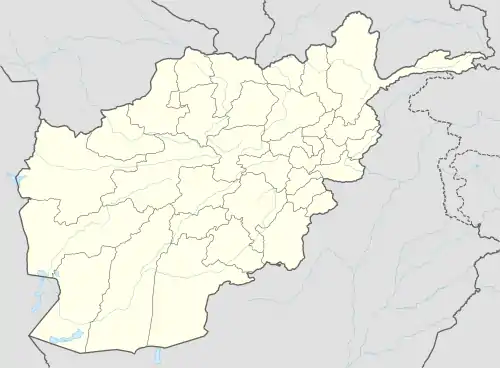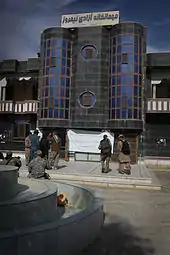Zaranj
Zaranj or Zarang (Persian/Pashto/Balochi: زرنج) is a city in southwestern Afghanistan, near the border with Iran, which has a population of 160,902 people as of 2015.[2] It is the capital of Nimruz province and is linked by highways with Lashkar Gah to the east, Farah to the north and the Iranian city of Zabol to the west. Zaranj is a major border crossing between Afghanistan and Iran, which is of significant importance to the trade-route between Central Asia and South Asia with the Middle East.
Zaranj
زرنج Zarange | |
|---|---|
 Trucks wait to cross into Iran at the Zaranj border crossing. | |
 Zaranj Location in Afghanistan | |
| Coordinates: 30°57′36″N 61°51′36″E | |
| Country | |
| Province | Nimruz Province |
| District | Zaranj District |
| Elevation | 476 m (1,562 ft) |
| Population (2015) | |
| • City | 49,851 |
| • Urban | 160,902[1] |
| Time zone | UTC+4:30 |
Zaranj is a Trading and Transit Hub in western Afghanistan, on the border with Iran. There are 17,878 residential dwellings in Zarat and 1,759 hectares of agricultural land.[3] Commercial land use is clustered on the main road to Iran.
The history of Zaranj dates back over 2500 years and Ya'qub ibn al-Layth al-Saffar, founder of the Saffarid dynasty was born in the city.
History
Modern Zaranj bears the name of an ancient city whose name is also attested in Old Persian as Zranka.[4] In Greek, this word became Drangiana. Other historical names for Zaranj include Zirra,[5] Zarangia, Zarani etc.[6] Ultimately the word Zaranj is derived from the ancient Old Persian word zaranka ("waterland"; cf. Pashto dzaranda).
Achaemenid Zranka, the capital of Drangiana, was almost certainly located at Dahan-e Gholaman, southeast of Zabol in Iran.[7] After the abandonment of that city, its name, Zarang or Zaranj in later Perso-Arabic orthography, was transferred to the subsequent administrative centers of the region, which itself came to be known as Sakastān, then Sijistan[8] and finally Sistān. Medieval Zaranj is located at Nād-i `Alī, 4.4 km north of the modern city of Zaranj.[9] According to the Arab geographers, prior to medieval Zaranj, the capital of Sistan was located at Ram Shahristan (Abar shariyar). Ram Shahristan had been supplied with water by a canal from the Helmand River, but its dam broke, the area was deprived of water, and the populace moved three days' march to found Zaranj.[10] This Zaranj appears on the Peutinger Map of late Antiquity.
The area came under Muslim rule in 652, when Zaranj surrendered to the governor of Khurāsān; it subsequently became a base for further caliphal expansion in the region. In 661, a small Arab garrison reestablished its authority in the region after having temporarily lost control due to skirmishes and revolts.[11] A Nestorian Christian community is recorded in Zaranj in the sixth century, and by the end of the eighth century there was a Jacobite diocese of Zaranj.[12] In the 9th century Zaranj was the capital of the Saffarid dynasty, whose founder was the local coppersmith turned warlord, Ya'qub ibn al-Layth al-Saffar.[13] It became part of the Ghaznavids, Ghorids, Trimurids, Safavids and others. Defeated by the Samanids in 900, the Saffarids sank to a position of regional importance, until conquered by Mahmud of Ghazni in 1003.[14] Subsequently, Zaranj served as the capital of the Nasrid (1029-1225) and Mihrabānid (1236-1537) maliks of Nīmrūz.[15]
In the early 18th century, the city became part of the Afghan Hotaki dynasty until they were removed from power in 1738 by Nader Shah of Khorasan. By 1747, Ahmad Shah Durrani made it part of modern Afghanistan after he united all the different tribes and acquired the territories from northeastern Iran to Delhi in India. Under the modern Afghan governments, the area was known as Farah-Chakansur Province until 1968, when it was separated to form the provinces of Nimruz and Farah.[16] The city of Zaranj became the capital of Nimroz province.
Recent developments

A new highway called Route 606 was built between Zaranj and Delaram in Farah province by the Indian Government's Border Roads Organization at a cost of about US$136 million to open up a link between the deep sea port at Chabahar in Iran to Afghanistan's main ring road highway system which connects Kabul, Kandahar, Herat, Mazar-i-Sharif and Kunduz. The 215-kilometre-long (134 mi) highway, a symbol of India's developmental work in the war-ravaged country, was handed over to Afghan authorities by Indian External Affairs Minister Pranab Mukherjee in January 2009 in the presence of Afghan President Hamid Karzai and Foreign Minister Rangeen Dadfar Spanta. "Completion of the road reflects the determination of both India and Afghanistan that nothing can prevent or hinder collaboration between the two countries," Mukherjee said at a function to mark this handover. On the occasion, Karzai said, the completion of the project is a message to those who want to stop cooperation between India and Afghanistan. "Our cooperation will not stop". The Taliban was opposed to this project and launched frequent attacks on the construction workers in an attempt to force the winding up of the work. A total of six Indians, including a Border Roads Organisation driver and four ITBP soldiers, and 129 Afghans were killed in these attacks.
The province has been one of the 7 (Nimruz, Helmand, Kandahar, Uruzgan, Ghazni, Paktika and Zabul) where the Taliban have been recently regrouping. On 14 August 2012 dozens of civilians were killed in Zaranj by several suicide-bombers in a major terrorist attack on the city.[17]
Due to Zaranj's close proximity to Iran, the city relies mostly on Iranian products. With the increase of trade the Afghan Border Police is dealing with a rise in smuggling, particularly illegal drugs and weapons. The overall economic situation is becoming better for the local population of the city. Hundreds of trucks containing merchandise from the Middle East enter the city on a daily basis.
In the last decade, the U.S. Marines and others of the International Security Assistance Force (ISAF) have been visiting Zaranj city. The US Marines and other U.S. officials are involved with the Afghan government in major development projects. This includes improvement made to the irrigation network of the city, building of Afghan military and Afghan National Police barracks as well as a hospital and a school.
The city is served by Zaranj Airport, which is also being improved by the United States. US Marines assigned to 3rd Marine Aircraft Wing have been visiting Zaranj since US Marine Base Forward Operating Base Delaram was built in Delaram district of Zaranj. The 3rd Marine Aircraft Wing built two concrete helicopter landing zones on western side of the gravel runway of Zaranj Airport to ease the landing of USMC V-22 Osprey helicopters from 3rd Battalion 4th Marines. The helipads now serve all helicopters landing at Zaranj airport.
Climate
Zaranj has a hot desert climate (Köppen climate classification BWh) with very hot summers and cool winters. Precipitation is very low, and mostly falls in winter. Temperatures in summer may approach 50 °C (122 °F); the highest reliably recorded temperature is 49.6 °C (121.3 °F), and the lowest is −13.2 °C (8.2 °F).[18]
| Climate data for Zaranj | |||||||||||||
|---|---|---|---|---|---|---|---|---|---|---|---|---|---|
| Month | Jan | Feb | Mar | Apr | May | Jun | Jul | Aug | Sep | Oct | Nov | Dec | Year |
| Record high °C (°F) | 24.1 (75.4) |
30.6 (87.1) |
37.0 (98.6) |
45.0 (113.0) |
51.0 (123.8) |
49.7 (121.5) |
49.3 (120.7) |
50.0 (122.0) |
49.7 (121.5) |
42.0 (107.6) |
36.0 (96.8) |
27.8 (82.0) |
51.0 (123.8) |
| Average high °C (°F) | 14.3 (57.7) |
18.7 (65.7) |
25.0 (77.0) |
32.6 (90.7) |
37.3 (99.1) |
42.8 (109.0) |
42.5 (108.5) |
41.3 (106.3) |
37.0 (98.6) |
31.2 (88.2) |
23.1 (73.6) |
17.7 (63.9) |
30.3 (86.5) |
| Daily mean °C (°F) | 6.5 (43.7) |
10.0 (50.0) |
15.7 (60.3) |
23.3 (73.9) |
29.1 (84.4) |
33.4 (92.1) |
35.0 (95.0) |
32.3 (90.1) |
27.2 (81.0) |
21.9 (71.4) |
13.1 (55.6) |
8.7 (47.7) |
21.3 (70.4) |
| Average low °C (°F) | 0.1 (32.2) |
2.9 (37.2) |
7.7 (45.9) |
14.7 (58.5) |
20.0 (68.0) |
25.2 (77.4) |
27.3 (81.1) |
24.9 (76.8) |
18.5 (65.3) |
12.3 (54.1) |
4.8 (40.6) |
0.7 (33.3) |
13.3 (55.9) |
| Record low °C (°F) | −13.2 (8.2) |
−8.2 (17.2) |
−5.2 (22.6) |
1.0 (33.8) |
5.0 (41.0) |
16.0 (60.8) |
18.4 (65.1) |
13.2 (55.8) |
3.9 (39.0) |
−2.7 (27.1) |
−7.1 (19.2) |
−8.8 (16.2) |
−13.2 (8.2) |
| Average precipitation mm (inches) | 19.7 (0.78) |
9.9 (0.39) |
11.2 (0.44) |
2.4 (0.09) |
0.6 (0.02) |
0.0 (0.0) |
0.0 (0.0) |
0.0 (0.0) |
0.0 (0.0) |
1.2 (0.05) |
1.4 (0.06) |
5.1 (0.20) |
51.5 (2.03) |
| Average rainy days | 3 | 2 | 2 | 2 | 0 | 0 | 0 | 0 | 0 | 0 | 1 | 1 | 11 |
| Average relative humidity (%) | 55 | 50 | 44 | 40 | 35 | 29 | 28 | 29 | 33 | 41 | 49 | 54 | 41 |
| Source: NOAA (1969-1983)[19] | |||||||||||||
Demographics
According to the Ministry of Rural Rehabilitation and Development (MRRD) along with UNHCR and Central Statistics Office (CSO) of Afghanistan, the population of Zaranj was around 49,851 in 2004. The ethnic groups are as follows: Baloch 44%, Pashtun 34% and Tajik 22%.[20]
The city of Zaranj has a population of 160,902 people.[21]
Route 606: Delaram-Zaranj Highway
The Delaram–Zaranj Highway, also known as Route 606, is a 217-km or 135-mile-long two-lane road built by India in Afghanistan, connecting Delaram in Farah Province with Zaranj in neighbouring Nimruz Province near the Iranian border.[22] It connects the Afghan–Iranian border with the Kandahar–Herat Highway in Delaram, which provides connectivity to other major Afghan cities via A01, including to India's planned mining operation in Hajigak mining concession. Route 606 reduces travel time between Delaram and Zaranj from the earlier 12–14 hours to just 2 hours. India-Iran signed an agreement in May 2016 to connect it to Port of Chabahar with rail and road links.
References
- "The State of Afghan Cities report 2015". Archived from the original on 2015-10-31.
- "The State of Afghan Cities Report 2015". Retrieved 20 October 2015.
- "The State of Afghan Cities Report 2015". Retrieved 20 October 2015.
- Schmitt, Rüdiger (15 December 1995). "DRANGIANA or Zarangiana; territory around Lake Hāmūn and the Helmand or Hindmand river in modern Sīstān". Encyclopædia Iranica.
The name of the country and its inhabitants is first attested as Old Persian z-r-k (i.e., Zranka)in the great Bīsotūn (q.v. iii) inscription of Darius I (q.v.; col. I l. 16), apparently the original name. This form is reflected in the Elamite (Sir-ra-an-qa and variants), Babylonian (Za-ra-an-ga), and Egyptian (srng or srnḳ) versions of the Achaemenid royal inscriptions, as well as in Greek Zarángai, Zarangaîoi, Zarangianḗ (Arrian; Isidore of Charax), and Sarángai (Herodotus) and in Latin Zarangae (Pliny). Instead of this original form, characterized by non-Persian z (perhaps from proto-IE. palatal *γ or *γh), in some Greek sources (chiefly those dependent upon the historians of Alexander the Great, q.v.) the perhaps hypercorrect Persianized variant (cf. Belardi, p. 183) with initial d-, *Dranka (or even *Dranga?), reflected in Greek Drángai, Drangḗ, Drangēnḗ, Drangi(a)nḗ (Ctesias; Polybius; Strabo; Diodorus; Ptolemy; Arrian; Stephanus Byzantius) and Latin Drangae, Drangiana, Drangiani (Curtius Rufus; Pliny; Ammianus Marcellinus; Justin) or Drancaeus (Valerius Flaccus, Argonautica 6.106, 6.507) occurs.
- Ten Thousand Miles in Persia: Or, Eight Years in Irán By Percy Sykes, pg. 363
- Vogelsang, Willem (2002). The Afghans. Wiley-Blackwell. p. 162. ISBN 0-631-19841-5. Retrieved 2011-01-21.
- Gnoli (1993).
- “….As for ibn-Samurah, he established his rule over everything between Zaranj and Kishsh of the land of al-Hind, and over that part of the region of the road of ar-Rukhkhaj which is between it and the province of ad-Dhawar”, The origins of the Islamic State, Part II (1924) page 143 by Murgotten, Francis Clark
- Schmitt (1995).
- Guy Le Strange. The lands of the eastern caliphate: Mesopotamia, Persia, and Central Asia, from the Moslem conquest to the time of Timur. Cambridge geographical series. General editor: F. H. H. Guillemard. reprint Publisher CUP Archive, 1930. Originally published 1905.
- Islamic History: A New Interpretation By Muhammad Abdulhavy Shaban
- Fiey, Pour un Oriens Christianus, 281
- Ariana Antiqua: A Descriptive Account of the Antiquities and Coins of Afghanistan By Horace Hayman Wilson, pg. 154
- Joel L. Kraemer, Philosophy in the Renaissance of Islam: Abū Sulaymān Al-Sijistānī and His Circle, Vol. VIII, ed. Itamar Rabinovich, William M. Brinner, Martin Kramer, Joel L. Kraemer and Shimon Shamir, (Brill, 1986), 4.
- C.E. Bosworth (2002). "Zaranj". In P. J. Bearman; T. Bianquis; C. E. Bosworth; E. Van Donzel; W. P. Heinrichs (eds.). The Encyclopaedia of Islam. Brill. p. 459.
- Frank Clements. Conflict in Afghanistan: a historical encyclopedia. ABC-CLIO, 2003. ISBN 1-85109-402-4, ISBN 978-1-85109-402-8. Pg 181
- Afghan blasts: 'Dozens killed' in Nimroz province
- Extreme Temperatures From Around the World
- "Zaranj Climate Normals 1969-1983". National Oceanic and Atmospheric Administration. Retrieved December 26, 2012.
- "Zaranj" (PDF). Ministry of Rural Rehabilitation and Development. April 2007. Archived from the original (PDF) on 6 March 2016. Retrieved 2011-01-21.
- "The State of Afghan Cities Report 2015". Retrieved 20 October 2015.
- "India hands over strategic highway to Afghanistan". Hindu. 2009-01-23. Retrieved 2011-08-10.
Bibliography
- Bosworth, C. E., "Sistān ii. In the Islamic period," in Encyclopaedia Iranica (2011).
- Gnoli, G., "Dahan-e Ḡolāmān," in Encyclopaedia Iranica, vol. 6 (1993), 582–585.
- Le Strange, Guy (1905). The Lands of the Eastern Caliphate: Mesopotamia, Persia, and Central Asia, from the Moslem Conquest to the Time of Timur. New York: Barnes & Noble, Inc. OCLC 1044046.
- Schmitt, R., "Drangiana," in Encyclopaedia Iranica, vol. 7 (1995) 534–537.
External links
| Wikimedia Commons has media related to Zaranj. |